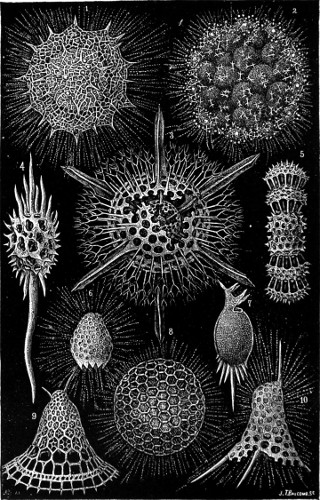ii

RADIOLARIA.iii
THE
MICROSCOPE
ITS HISTORY, CONSTRUCTION, AND APPLICATION
BEING A FAMILIAR INTRODUCTION TO THE USE OF
THE INSTRUMENT, AND THE STUDY OF
MICROSCOPICAL SCIENCE
By JABEZ HOGG, M.R.C.S., F.R.M.S.,
FORMERLY AND FOR TWENTY-FIVE YEARS SURGEON TO THE ROYAL WESTMINSTER OPHTHALMIC
HOSPITAL; PAST PRESIDENT OF THE MEDICAL MICROSCOPICAL SOCIETY; HONORARY
FELLOW OF THE ACADEMY OF SCIENCES, PHILADELPHIA; OF THE MEDICO-LEGAL
SOCIETY, NEW YORK; OF THE BELGIAN MICROSCOPICAL SOCIETY, ETC.; AUTHOR
OF “ELEMENTS OF NATURAL PHILOSOPHY,” “A MANUAL OF
OPHTHALMOSCOPIC SURGERY,” ETC.
WITH UPWARDS OF
NINE HUNDRED
ENGRAVED
AND COLOURED
ILLUSTRATIONS BY
TUFFEN WEST
AND
OTHER ARTISTS
 An 18th Century Microscope.
An 18th Century Microscope.
FIFTEENTH EDITION
RE-CONSTRUCTED,
RE-WRITTEN,
REVISED, AND
ENLARGED
THROUGHOUT
LONDON AND NEW YORK
GEORGE ROUTLEDGE & SONS, LIMITED
1898
iv
BRADBURY, AGNEW, & CO. I.D., PRINTERS,
LONDON AND TONBRIDGE.
v
PREFACE TO THE FIFTEENTH EDITION.
The First Edition of this work appeared in 1854, a time in thehistory of the Microscope when the instrument, as an aid tooriginal scientific research, may be said to have been in its infancy.Then certainly it was seldom employed in the laboratory or themedical schools. Now, however, as I anticipated, it has asserted itsproper position, and has at length become one of the most importantauxiliaries to science, and a direct incentive to original work, whileit has doubtless exercised considerable influence over the student’spower of observation, and materially assisted in his studies, let hisultimate object and pursuits be what they may.
The greater use made of the Microscope has likewise conferredbenefits of untold value upon the arts and industries of the country,thereby adding to the national prosperity in ways as manifold asunique. The Microscope has also proved of immense value in thepromotion of the health of the community, and the art and scienceof healing, since the theory of medicine has become a science, restingon the minute microscopical examination of animal tissues.
The work of research in the sister sciences and by other methodshas, during the last decade, received a corresponding impetus, whileit has undoubtedly tended towards elaboration and specialisation inall departments. In consequence, the progress of microscopical sciencehas become more dependent upon the specialist for gaining accurateknowledge and for certain important details seen to be branchingout in many directions. There never was a time when the instrumentwas so constantly and generally resorted to and with so much confidenceand advantage, as the present. It has shown itself equal to thetask imposed—that of teaching the eye to see things that are new,and also, what is perhaps